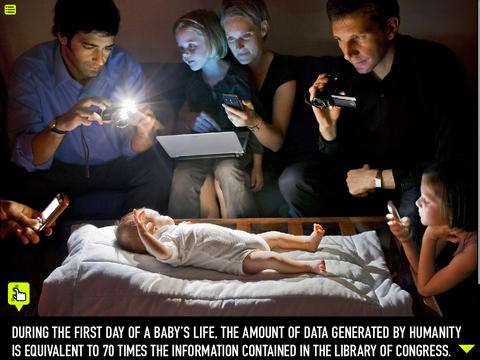
Image from The Human Face of Big Data
Day 1
Readings:
Before class, students will read Terms of Service graphic novella by Michael Keller and Josh Neufeld. This will launch our first unit on Big Data and Human Culture, but also does a great job of previewing many of the topics we have slated for the remainder of the course.
In Class:
- Pair and Share: Individually, students write down their top three take-aways from the reading. Then, they pair up, and as a group come up with a combined top three. Have each group share one of the items on their list, and allow these to be open for discussion with the entire class. During the course of this discussion, make sure we as a group emphasize the main ideas from the reading.
- Take out purse and smart phone, and go through and make a note of everything you have that might get connected to a big data database. Ask for volunteers to share these items with the class and discuss the relevance.
- Share BlueKai’s Little Blue Book for selling access to large databases. Share example of how big data works by combining multiple datasets:
Big data management organizations such as BlueKai and Exelate, as well, work to aggregate and sell this data as part of marketing strategies. On its website, BlueKai explains its partnership with 30 sources of big data and how each dataset can help customize microtargeted advertising (BlueKai 2014). One of its partners, MasterCard Advisors, “analyzes the spending patterns across billions of anonymous transactions to segment like-spending patterns into anonymous groups called micro-segments” (61). Experian Marketing Services’ “TrueTouch segmentation system offers 11 Touch-points to define the motivational messages that appeal to various audiences. Understanding Touch-points makes it possible for advertisers to align offers with the values and attitudes of the consumers they wish to reach, using language proven to resonate” (41). Acxiom offers demographic information (occupation, gender, education), real property data (home type, home value, length of residence), age, date of birth, income, net worth, and buying activity categorized by type based on purchase history information (7). Combining just these three datasets with information from Facebook would allow one to create a highly micro-targeted ad to someone who is known to buy a particular type of product, and provide the advertiser with language to which the consumer is particularly drawn.
This took the entirety of the class period. However, if time permitted, I had activities from the teacher resources related to the Human Face of Big Data ready.
Homework:
Complete the following blog post before you come our next meeting:
In class, we discussed some of the ways that our every-day actions are already connected to big data. Your assignment for this blog post (400-500 words or media equivalent) is to track a day in the life of your data. Choose one day between now and the next time we meet, and keep track using a notebook or your cell phone of every action that you take which could feasibly be included in a big database. Consider the following example:
After doing this for an entire day, you should post about the following:
- Summarize the contributions you believe you made to big data for the day.
- What does this contribution say about who “you” are?
- Do you feel that it would be feasible to opt-out of your inclusion in big data?
- Generate what Dan Geer calls a Tomorrow Question (see Terms of Service reading).
- Please make sure you comment substantially on at least two other posts.
Consider the following example, both as a way to think about how you use data, but also as a way of presenting your results:
[slideshare id=43622424&doc=phoenixmobilefestival2014presentation1-150117182754-conversion-gate01]
[If you are considering expanding this post into your longer final post for HASTAC, you could try to go an entire day without contributing any of your data to a database, and blog about the challenges this presents.]
Day 2
Readings:
Read Chapter 1 of Uncharted: Big Data as a Lens on Human Culture.
You should also read Six Provocations for Big Data by dana boyd and Kate Crawford.
In Class:
- Discuss blog entries. What stood out? What did you notice about the entries? Was it what you expected? Were you surprised by anything?
- In response to the blog entries, I quickly put together the following presentation before class to highlight some of the issues that were raised in the blogs, and point out the ways that big data makes an impact at the cultural level, and not just the individual level:
- Ink-shedding activity: Students were assigned a number and began the ink-shedding with the question that corresponded with their number. These questions are based on the assigned readings for class.
- To what degree do you think big data encourages the seeing of patterns where none exist? What potential impact might this have.
- What problems might arise if researchers don’t disclose limitations of their data?
- Do you think publicly accessible information is fair game for research? What if it’s anonymized?
- What do you think is most problematic about the digital divide mentioned by boyd and Crawford?
- How will the focus on correlation over causation impact the way we understand the world?
- How might formal education be impacted by the existence of big data?
- After four rounds of individual writing, everyone with the same number got together and created a summary of their group’s writing. These were presented to the class for discussion.